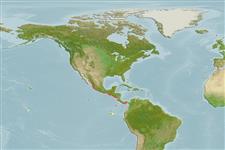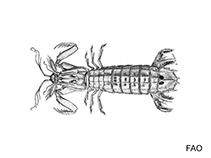Squilla panamensis Bigelow, 1891
Panama mantis shrimp| Native range | All suitable habitat | Point map | Year 2050 |

|
| This map was computer-generated and has not yet been reviewed. |
| Squilla panamensis AquaMaps Data sources: GBIF OBIS |
Upload your photos
Google image | No image available for this species;
drawing shows typical species in Squillidae.
Google image | No image available for this species;
drawing shows typical species in Squillidae.
Classification / Names Common names | Synonyms | CoL | ITIS | WoRMS
Malacostraca | Stomatopoda | Squillidae
Environment: milieu / climate zone / depth range / distribution range Ecology
Benthic; depth range 18 - 102 m (Ref. 83920). Tropical; 23°N - 11°S, 106°W - 78°W
Distribution Countries | FAO areas | Ecosystems | Occurrences | Introductions
Eastern Pacific: from southern Sinaloa to Huacho, Peru.
Length at first maturity / Size / Weight / Age
Maturity: Lm ? range ? - ? cm Max length : 17.3 cm TL male/unsexed; (Ref. 121708)
Occurs in coasts, found in the continental shelf (Ref. 121707). Benthic species found on muddy and sandy bottoms (Ref. 83920).
Life cycle and mating behavior Maturity | Reproduction | Spawning | Eggs | Fecundity | Larvae
Some members of the order Stomatopoda pair for life and some come together only to mate. Males produce sperm ducts rather than spermatophores; females can brood a maximum of 50,000 eggs. Life cycle: Eggs hatch to a planktonic zoea which lasts for 3 months.
Main reference
References | Coordinator | Collaborators
Landa-Jaime, V., J. Arciniega-Flores, R.G. de Quevedo-Machain, J.E. Michel-Morfin and G. González-Sansón. 1997. (Ref. 3616)
IUCN Red List Status (Ref. 130435)
CITES status (Ref. 108899)
Not Evaluated
CMS (Ref. 116361)
Not Evaluated
Threat to humans
Harmless
Human uses
Fisheries: commercial
| FishSource |
Tools
More information
Age/Size
Growth
Length-weight
Length-length
Morphology
Larvae
Abundance
Growth
Length-weight
Length-length
Morphology
Larvae
Abundance
Internet sources
BHL | BOLD Systems | CISTI | DiscoverLife | FAO(Publication : search) | Fishipedia | GenBank (genome, nucleotide) | GloBI | Gomexsi | Google Books | Google Scholar | Google | PubMed | Tree of Life | Wikipedia (Go, Search) | Zoological Record
Estimates based on models
Preferred temperature
(Ref. 115969): 19.2 - 26.7, mean 23.4 (based on 19 cells).



